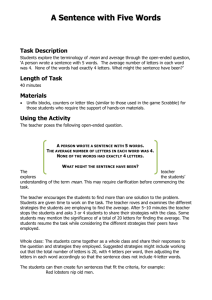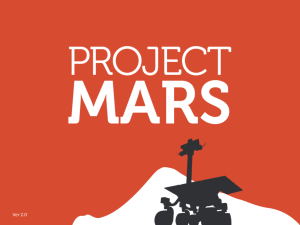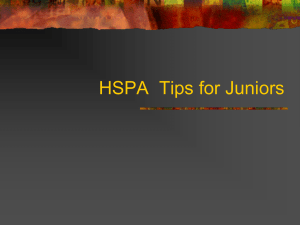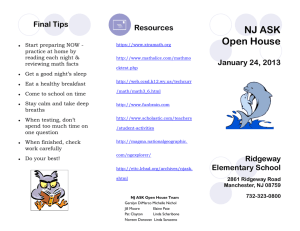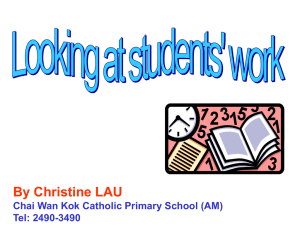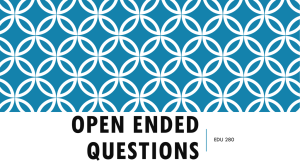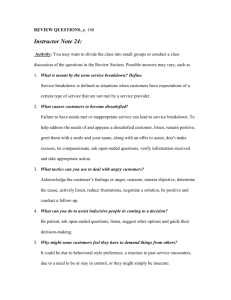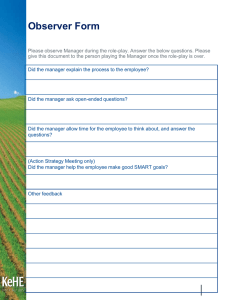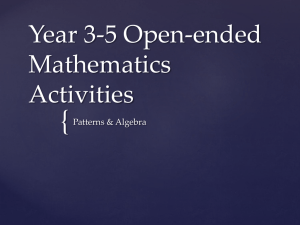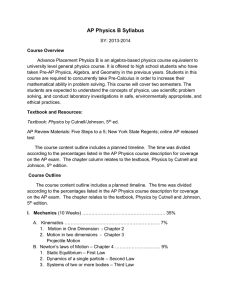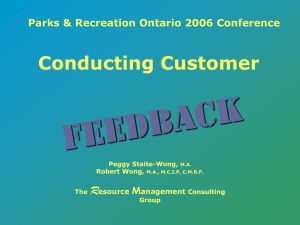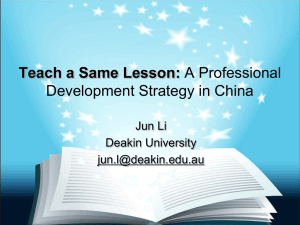Problem Solving - morelandnumeracyaiznetwork
advertisement
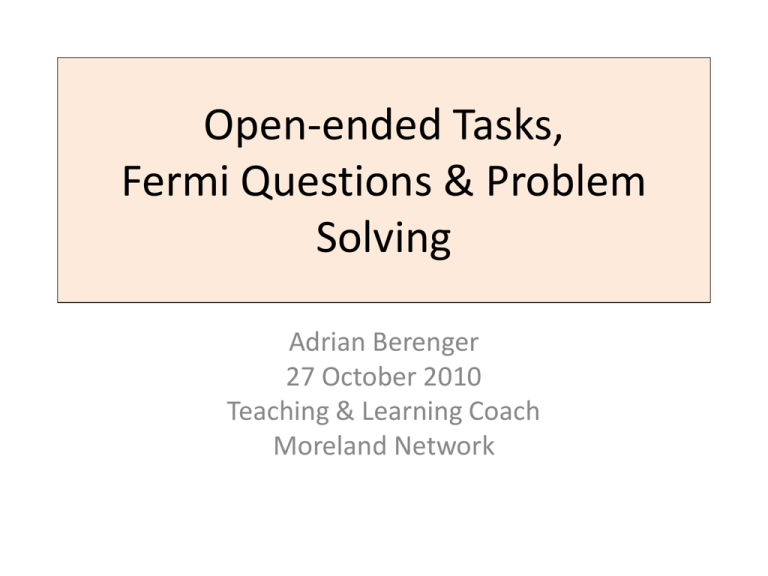
Open-ended Tasks, Fermi Questions & Problem Solving Adrian Berenger 27 October 2010 Teaching & Learning Coach Moreland Network Assessment Assessment PoLT 5. Assessment practices are an integral part of teaching and learning Assessment contributes to planning at a number of levels. Monitoring of student learning is continuous and encompasses a variety of aspects of understanding and practice. Assessment criteria are explicit and feedback is designed to support students' further learning and encourage them to monitor and take responsibility for their own learning. 5.1 Assessment practices reflect the full range of learning program objectives 5.2 The teacher ensures that students receive frequent constructive feedback that supports further learning 5.3 The teacher makes assessment criteria explicit 5.4. Assessment practices encourage reflection and self assessment 5.5 The teacher uses evidence from assessment to inform planning and teaching Formative Assessment Examples • Teacher observation • Checklists • Drawings, photos, journal entries • Interviews, probes • Portfolios • Rich tasks and rubrics • Peer and student self-assessment Benefits of Group Work • Everyone has a job to do • It is easier with many brains ie. ‘Many hands make light work’ • Different strategies are visible or transparent to the group • Mathematical Language can be used throughout the task • The group can self-regulate and knows when they’ve completed the task Open-ended Questions • Require more than remembering a fact or reproducing a skill • Have several acceptable answers • Engage learners of different abilities • Enable students to learn by answering the question • Enable the teacher to learn about each student from the attempt Whole Group Activity A piece of ribbon 1m long is used to tie a present. 20cm of the ribbon is used to form a bow. How big is my present? – How can this problem be modified to cater for different student abilities? – How do you want students to record their thinking? Writing an Open Question • Some Examples – A rectangle has a perimeter of 16cm. What might the dimensions be? – The hour and minute hands of a clock are at 90o. What might the time be? – Using the published ladder, what is the chance of your team winning the grand final? Other Examples • What might this be a graph of? • Present this information in different ways • The average of three numbers is 7.1. One of the numbers is 11.2. What might the other numbers be? Sullivan & Lilburn (2004) Jan Feb Mar Method 1 • Omit enough information so that, although the answer remains the same, the digits required to achieve the answer becomes variable. TRADITIONAL 249 + 173 OPEN-ENDED 2** + *7* 422 Method 1 (continued) TRADITIONAL OPEN-ENDED Two fifths of 250 students borrow books from the library each day. Calculate the number of students who borrow books each day. Two fifths of the students in a school borrow books from the library each day. How many students might there be in the school and how many of them borrow books each day? Find the missing angle on this trapezoid 40◦ What might the angles on this trapezoid be? 140◦ Method 2 • Work backwards from the answer. Begin with a closed task. Calculate the answer, then work backwards and using the context of the question, create a question that would allow multiple responses to achieve the same answer. TRADITIONAL OPEN-ENDED The following numbers represents the temperature of 5 consecutive days in Melbourne: 44◦C, 42◦C, 36◦C, 22◦C, 29◦C. Find the average temperature. The average temperature over five consecutive days in Melbourne was 35◦C. The highest temperature was 44◦C. What might the temperature have been on the other days? Method 2 (continued) TRADITIONAL OPEN-ENDED 35.0 X 0.5 What is the volume of the cylinder? 4cm 6 cm The answer is 17.5 What might the question be? What might the dimensions of a cylinder prism that has a volume of 300 cm3? Height of Statue of Liberty • What is the height of the Statue of Liberty if the length of her right arm is 42 feet. • Students work in groups and then prepare a presentation for the whole class including the following – An account of strategies that were used to solve the problem. – How were concrete materials used? – A self-evaluation using a scoring rubric Fermi Questions • How many 10 year olds are there in Australia? • How many litres of fluid have you consumed in your lifetime? • How much toothpaste do Australians use during a typical week? • How much money do your parents spend on you in a year? • How much money have your parents spent on you up until now? • How much money would your parents spend on you by the time you finish primary school? Problem solving (& investigations) • Problem solving strategies • Problem solving definitions • Models • Understanding the process • Benefits • Investigations Problem Solving Strategies • • • • • • • • Act it out (role play) Draw a Picture Trial & Error Guess & Check Make a Model Make a Table Make a List Create a Rule • • • • • Make a Chart or Graph Reduce the Problem Work Backwards Use Logic Re-write the problem Ask Think Do Problem Solving • ...to find a way where no way is known off-hand. For a question to be a problem, it must present a challenge that cannot be resolved by some routine procedure. Problem solving is a process of accepting a challenge and striving to resolve it Polya, 1990, 1965 in Booker et al (2004) p. 43 • Teaching problem-solving is not about the answer to a problem. It is about thinking and sharing strategies; and developing processes that solve problems. In other words, the answer isn’t important - the solution process is. The journey matters more than the destination. Berenger, 2010, RMIT TCHE2363 Small Group Activities • Developing part of a lesson plan on… – How many handshakes…? – Matchstick Problems Mathematical Investigations • Involves problem-solving but is extended, often involves research and sharing of ideas, and allows students to make connections with other areas of learning. Embedded • Problem solving is integral to the learning program, and not simply an add-on or something you do once a week for an hour… • Problem solving refers to ‘Working Mathematically’ and ‘Thinking’ within the VELS • National Curriculum Frameworks will specify problem solving as a significant component of any teaching & learning program The Benefits • Builds new mathematical knowledge (ideas, sense making) & connects mathematical ideas… • Develops a range of strategies… • Supports the development of positive student selfesteem… • Supports assessment for learning… • Caters for the diverse range of student learning needs… • Engagement! Classroom learning environment… Resources • E5 Instructional Model – www.education.vic.gov.au • Principals Of Learning & Teaching (PoLT) – www.education.vic.gov.au • VELS – http://vels.vcaa.vic.edu.au • Open-ended tasks – Sullivan, P. & Lilburn, P. 1997. Open-ended Maths Activities: Using ‘good’ questions to enhance learning. Oxford University Press Melbourne. • Fermi Problems – Maths300 – Bobis, J. et al. Mathematics for children: Challenging children to think mathematically
